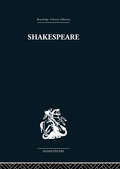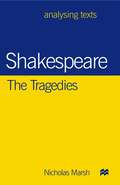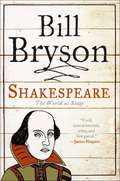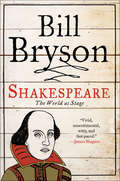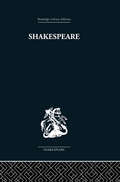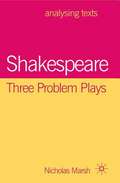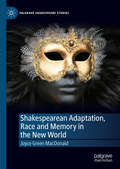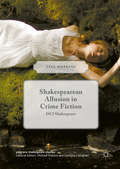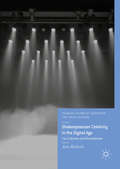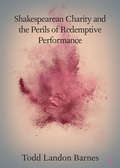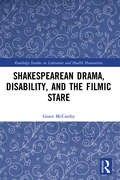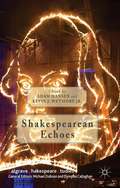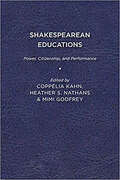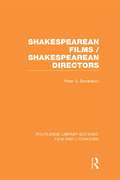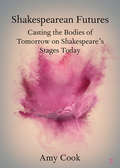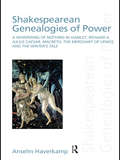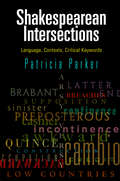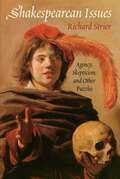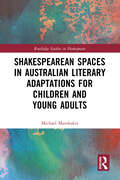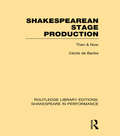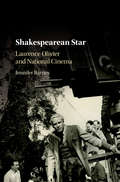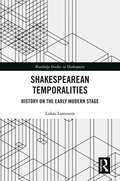- Table View
- List View
Shakespeare: The Poet in his World
by M. C. BradbrookFirst published in 1978. In this study, Shakespeare's own life story and the development of English theatrical history are placed in the wider context of Elizabethan and Jacobean times, but the works themselves are the final objective of this 'applied biography'. The main contention of the book is that Shakespeare's life was the lure of the stage itself which inspired him to transform what everyday life provided into the worlds of Hamlet, King Lear and Prospero.
Shakespeare: The Tragedies (Analysing Texts)
by Nicholas MarshThought of as Shakespeare's most powerful works, the four great tragedies, Hamlet, King Lear, Othello and Macbeth, are texts of unparalleled richness and depth, stimulating and exciting to study. This book takes extracts and examines them, explaining how the critic can use particular techniques to bring out complexities of meaning, understand the patterns of metaphor and the rhythms of the poetry and appreciate the ever-living drama. Chapters on the openings and endings of plays, heroes and heroines, society, humour, imagery and the tragic universe guide the student on a journey of inquiry into the nature of Shakespeare's tragic vision. Far from simplifying Shakespeare, the reader is challenged to confront the depth and subtlety of the dramas, and to enjoy the analytical pursuit of ever finer insight, ever fuller understanding.
Shakespeare: The World as Stage
by Bill BrysonAmerican native Bryson, alive and well in England, sets out what little is known about the life of the Elizabethan playwright and samples the voluminous scholarship about his work and its influence on English as a language and a body of literature. His approach is lighthearted and non-technical. Annotation ©2008 Book News, Inc., Portland, OR (booknews.com)
Shakespeare: The World as Stage
by Bill BrysonBill Bryson's bestselling biography of William Shakespeare takes the reader on an enthralling tour through Elizabethan England and the eccentricities of Shakespearean scholarship--updated with a new introduction by the author to commemorate the 400th anniversary of Shakespeare's deathWilliam Shakespeare, the most celebrated poet in the English language, left behind nearly a million words of text, but his biography has long been a thicket of wild supposition arranged around scant facts. With a steady hand and his trademark wit, Bill Bryson sorts through this colorful muddle to reveal the man himself. His Shakespeare is like no one else's--the beneficiary of Bryson's genial nature, his engaging skepticism, and a gift for storytelling unrivaled in our time.
Shakespeare: The art of the dramatist (Princeton Legacy Library #1782)
by Roland Mushat FryeThis edition first published in 1982. Previous edition published in 1972 by Houghton Mifflin. Outlining methods and techniques for reading Shakespeare's plays, Roland Frye explores and develops a comprehensive understanding of Shakespeare's drama, focussing on the topics which must be kept in mind: the formative influence of the particular genre chosen for telling a story, the way in which the story is narrated and dramatized, the styles used to convey action, character and mood, and the manner in which Shakespeare has constructed his living characterizations. As well as covering textual analysis, the book looks at Shakespeare's life and career, his theatres and the actors for whom he wrote and the process of printing and preserving Shakespeare's plays. Chapters cover: King Lear in the Renaissance; Providence; Kind; Fortune; Anarchy and Order; Reason and Will; Show and Substance; Redemption and Shakespeare's Poetics.
Shakespeare: Three Problem Plays (Analysing Texts Ser.)
by Nicholas MarshWritten in 1602-4, between Hamlet and the other great tragedies, Shakespeare's three Problem Plays are so called because they do not fit easily into the other groups of plays. They are awkward dramas, full of unresolved controversies, which leave audiences and readers unsettled by contradictory responses. Nicholas Marsh uses close analysis of extracts from the plays to explore how Shakespeare maintains competing discourses within a single text. In the first part of his study, Marsh highlights the multiple interpretations these plays provoke and provides useful sections on methods of analysis to encourage readers to develop their views independently. The second part of the book discusses the Problem Plays in relation to the playwright's other works, and examines their cultural and historical contexts. A comparison of five modern critical views and helpful suggestions for further reading provide a bridge to continuing study. In this essential guide to a complex set of plays, Marsh does not seek to reconcile the thorny issues these dramas leave open: rather, he equips the reader with the necessary critical tools to fashion their own synthesis.
Shakespearean Adaptation, Race and Memory in the New World (Palgrave Shakespeare Studies)
by Joyce Green MacDonaldAs readers head into the second fifty years of the modern critical study of blackness and black characters in Renaissance drama, it has become a critical commonplace to note black female characters’ almost complete absence from Shakespeare’s plays. Despite this physical absence, however, they still play central symbolic roles in articulating definitions of love, beauty, chastity, femininity, and civic and social standing, invoked as the opposite and foil of women who are “fair”. Beginning from this recognition of black women’s simultaneous physical absence and imaginative presence, this book argues that modern Shakespearean adaptation is a primary means for materializing black women’s often elusive presence in the plays, serving as a vital staging place for historical and political inquiry into racial formation in Shakespeare’s world, and our own. Ranging geographically across North America and the Caribbean, and including film and fiction as well as drama as it discusses remade versions of Othello, Romeo and Juliet, Antony and Cleopatra, and The Taming of the Shrew, Shakespearean Adaptation, Race, and Memory in the New World will attract scholars of early modern race studies, gender and performance, and women in Renaissance drama.
Shakespearean Allusion in Crime Fiction
by Lisa HopkinsThis book explores why crime fiction so often alludes to Shakespeare. It ranges widely over a variety of authors including classic golden age crime writers such as the four 'queens of crime' (Allingham, Christie, Marsh, Sayers), Nicholas Blake and Edmund Crispin, as well as more recent authors such as Reginald Hill, Kate Atkinson and Val McDermid. It also looks at the fondness for Shakespearean allusion in a number of television crime series, most notably Midsomer Murders, Inspector Morse and Lewis, and considers the special sub-genre of detective stories in which a lost Shakespeare play is found. It shows how Shakespeare facilitates discussions about what constitutes justice, what authorises the detective to track down the villain, who owns the countryside, national and social identities, and the question of how we measure cultural value.
Shakespearean Arrivals: The Birth of Character
by Nicholas LukeIn this distinctive study, Nicholas Luke explores the abiding power of Shakespeare's tragedies by suggesting an innovative new model of his character creation. Rather than treating characters as presupposed beings, Luke shows how they arrive as something more than functional dramatis personae - how they come to life as 'subjects' - through Shakespeare's orchestration of transformational dramatic events. Moving beyond dominant critical modes, Luke combines compelling close readings of Romeo and Juliet, Othello, Hamlet, Macbeth, and King Lear with an accessible analysis of thinkers such as Badiou, Zizek, Bergson, Whitehead and Latour, and the 'adventist' Christian tradition flowing from Saint Paul through Luther to Kierkegard. Representing a significant intervention into the way we encounter Shakespeare's tragic figures, the book argues for a subjectivity which is not singular or abiding, but perilous and leaping.
Shakespearean Celebrity in the Digital Age: Fan Cultures and Remediation (Palgrave Studies in Adaptation and Visual Culture)
by Anna BlackwellThis book offers a timely examination of the relationship between Shakespeare and contemporary digital media. By focusing upon a variety of ‘Shakespearean’ individuals, groups and communities and their ‘online’ presence, the book explores the role of popular internet culture in the ongoing adaptation of Shakespeare’s plays and his general cultural standing. The description of certain performers as ‘Shakespearean’ is a ubiquitous but often throwaway assessment. However, a study of ‘Shakespearean’ actors within a broader cultural context reveals much, not only about the mutable face of British culture (popular and ‘highbrow’) but also about national identity and commerce. These performers share an online space with the other major focus of the book: the fans and digital content creators whose engagement with the Shakespearean marks them out as more than just audiences and consumers; they become producers and critics. Ultimately, Digital Shakespeareans moves beyond the theatrical history focus of related works to consider the role of digital culture and technology in shaping Shakespeare’s contemporary adaptive legacy and the means by which we engage with it.
Shakespearean Charity and the Perils of Redemptive Performance (Elements in Shakespeare Performance)
by Todd Landon BarnesThis Element examines recent documentaries depicting marginalized youth who are ostensibly redeemed by their encounters with Shakespeare. These films emerge in response to four historical and discursive developments: the rise of reality television and its emphasis on the emotional transformation of the private individual; the concomitant rise of neoliberalism and emotional capitalism, which employ therapeutic discourses to individualize social inequality; the privatization of public education and the rise of so-called “no-excuses” or “new paternalist” charter schools; and the emergence of new modes of address infusing evangelical conversion narratives with a therapeutic self-help ethos.
Shakespearean Drama, Disability, and the Filmic Stare (Routledge Studies in Literature and Health Humanities)
by Grace McCarthyShakespearean Drama, Disability, and the Filmic Stare synthesizes Laura Mulvey’s male gaze and Rosemarie Garland-Thomson’s stare into a new critical lens, the filmic stare, in order to understand and analyze the visual construction of disability in adaptations of Shakespearean drama. The book explores the intersections of adaptation studies, film studies, Shakespeare studies, and disability studies to analyze twentieth and twenty-first century representations of both physical disability and ‘madness’ in global cinematic film, television film, and digital broadcast cinema in Shakespeare’s works. Shakespearean Drama, Disability, and the Filmic Stare argues that the filmic stare does not differentiate between male and female characters with disabilities, or between powerful and powerless figures in disability representation. This multi-disciplinary volume is ideal for disability studies scholars, Shakespeare scholars, and those interested in adaptations of Shakespeare’s famous works.
Shakespearean Echoes
by Jr Adam Hansen Kevin J. WetmoreShakespearean Echoes assembles a global cast of established and emerging scholars to explore new connections between Shakespeare and contemporary culture, reflecting the complexities and conflicts of Shakespeare's current international afterlife. Shakespearean echoes appear in diverse genres and cultural forms, from pop music of the seventies through the writing of Toni Morrison, to the book and film of Let the Right One In. Chapters deal with digital Shakespeare, Shakespeare on the web, and the powerful echoes of Shakespeare to be found in such seemingly unrelated texts as the television program Lost, sports broadcasts, and Game of Thrones. Within those discussions certain Shakespearean texts (such as Othello or Romeo and Juliet) recur; likewise certain modes of popular culture (such as science fiction) reappear. The collection helps readers navigate the diversity of Shakespeare's legacy.
Shakespearean Educations: Power, Citizenship, and Performance
by Elizabeth Renker Sandra M. Gustafson Theodore Leinwand Denise Albanese Coppélia Kahn Jonathan Burton Dayton Haskin Heather S. Nathans Jennifer Mylander Nan Johnson Marvin McAllister Rosemary KeglShakespearean Educations examines how and why Shakespeare’s works shaped the development of American education from the colonial period through the 1934 Chicago World’s Fair, taking the reader up to the years before the Servicemen’s Readjustment Act of 1944 (popularly known as the GI Bill), coeducation, and a nascent civil rights movement would alter the educational landscape yet again. The essays in this collection query the nature of education, the nature of citizenship in a democracy, and the roles of literature, elocution, theater, and performance in both. Expanding the notion of “education” beyond the classroom to literary clubs, private salons, public lectures, libraries, primers, and theatrical performance, this collection challenges scholars to consider how different groups in our society have adopted Shakespeare as part of a specifically “American” education. Shakespearean Educations maps the ways in which former slaves, Puritan ministers, university leaders, and working class theatergoers used Shakespeare not only to educate themselves about literature and culture, but also to educate others about their own experience. Published by University of Delaware Press. Distributed worldwide by Rutgers University Press.
Shakespearean Films/Shakespearean Directors (Routledge Library Editions: Film and Literature)
by Peter S. DonaldsonOriginally published in 1990, this book brought a new rigor and subtlety to the interpretation of film adaptations of Shakespeare. Drawing on traditional literary analysis, psychoanalysis, and current film theory about gender and subjectivity, the author combines close readings of seven films with historical and biographical studies of the directors who made them. Offering substantial readings of Jean-Luc Godard’s controversial deconstructed King Lear and of Liz White’s independent African-American Othello, Donaldson also applies his provocative and contemporary point of view to more familiar films. He reads Olivier’s Henry V in relation to its treatment of sexual difference; Olivier’s Hamlet in part as an expression of the director’s childhood sexual trauma; Kurosawa’s Throne of Blood as an allegory of the relationship between Western and Japanese cinema; and Zeffirelli’s immensely popular Romeo and Juliet in the light of its powerful homoerotic subtext. With striking perspectives on Shakespeare, on the movies as an expressive medium, and on the complex processes of cultural change, this is timeless useful reading for teachers and students of film and literature.
Shakespearean Futures: Casting the Bodies of Tomorrow on Shakespeare's Stages Today (Elements in Shakespeare Performance)
by Amy CookCasting is the process by which directors assign parts to actors, creating the idea of the character for the audience. Casting is how we rehearse change, as we come to see an expanded repertoire of the kinds of bodies that are selected to play the lead, the hero, and the villain. This Element focuses on the casting in productions of Shakespeare from 2017–2020 to demonstrate how casting functions affectively and cognitively to reimagine who can be what. The central argument is that directors are using casting as the central mode of meaning-making in productions of Shakespeare.
Shakespearean Genealogies of Power: A Whispering of Nothing in Hamlet, Richard II, Julius Caesar, Macbeth, The Merchant of Venice, and The Winter’s Tale
by Anselm HaverkampShakespearean Genealogies of Power proposes a new view on Shakespeare’s involvement with the legal sphere: as a visible space between the spheres of politics and law and well able to negotiate legal and political, even constitutional concerns, Shakespeare’s theatre opened up a new perspective on normativity. His plays reflect, even create, "history" in a new sense on the premises of the older conceptions of historical and legal exemplarity: examples, cases, and instances are to be reflected rather than treated as straightforwardly didactic or salvific. Thus, what comes to be recognized, reflected and acknowledged has a disowning, alienating effect, whose enduring aftermath rather than its theatrical immediacy counts and remains effective. In Shakespeare, the law gets hold of its normativity as the problematic efficacy of unsolved – or rarely ever completely solved – problems: on the stage of the theatre, the law has to cope with a mortgage of history rather than with its own success story. The exemplary interplay of critical cultural and legal theory in the twentieth-century – between Carl Schmitt and Hans Kelsen, Walter Benjamin and Ernst Kantorowicz, Hans Blumenberg and Giorgio Agamben, Robert Cover and Niklas Luhmann – found in Shakespeare’s plays its speculative instruments.
Shakespearean Intersections: Language, Contexts, Critical Keywords (Haney Foundation Series)
by Patricia ParkerWhat does the keyword "continence" in Love's Labor's Lost reveal about geopolitical boundaries and their breaching? What can we learn from the contemporary identification of the "quince" with weddings that is crucial for A Midsummer Night's Dream? How does the evocation of Spanish-occupied "Brabant" in Othello resonate with contemporary geopolitical contexts, wordplay on "Low Countries," and fears of sexual/territorial "occupation"? How does "supposes" connote not only sexual submission in The Taming of the Shrew but also the transvestite practice of boys playing women, and what does it mean for the dramatic recognition scene in Cymbeline?With dazzling wit and erudition, Patricia Parker explores these and other critical keywords to reveal how they provide a lens for interpreting the language, contexts, and preoccupations of Shakespeare's plays. In doing so, she probes classical and historical sources, theatrical performance practices, geopolitical interrelations, hierarchies of race, gender, and class, and the multiple significances of "preposterousness," including reversals of high and low, male and female, Latinate and vulgar, "sinister" or backward writing, and latter ends both bodily and dramatic.Providing innovative and interdisciplinary perspectives on Shakespeare, from early to late and across dramatic genres, Parker's deeply evocative readings demonstrate how easy-to-overlook textual or semantic details reverberate within and beyond the Shakespearean text, and suggest that the boundary between language and context is an incontinent divide.
Shakespearean Issues: Agency, Skepticism, and Other Puzzles
by Richard StrierIn Shakespearean Issues, Richard Strier has written a set of linked essays bound by a learned view of how to think about Shakespeare’s plays and also how to write literary criticism on them. The essays vary in their foci—from dealing with passages and key lines to dealing with whole plays, and to dealing with multiple plays in thematic conversation with each other. Strier treats the political, social, and philosophical themes of Shakespeare’s plays through recursive and revisionary close reading, revisiting plays from different angles and often contravening prevailing views.Part I focuses on characters. Moments of bad faith, of unconscious self-revelation, and of semi-conscious self-revelation are analyzed, along with the problem of describing characters psychologically and ethically. In an essay on “Happy Hamlet,” the famous melancholy of the prince is questioned, as is the villainy of Rosencrantz and Guildenstern, while another essay asks the reader to reconsider moral judgments and negative assessments of characters who may be flawed but do not seem obviously wicked, such as Edgar and Gloucester in King Lear.Part II moves to systems, arguing that Henry IV, Measure for Measure, and The Merchant of Venice raise doubts about fundamental features of legal systems, such as impartiality, punishments, and respect for contracts. Strier reveals King Lear’s radicalism, analyzing its concentration on poverty and its insistence on the existence and legitimacy of a material substratum to human life. Essays on The Tempest offer original takes on the play’s presentation of coercive power, of civilization and its discontents, and of humanist ideals. Part III turns to religious and epistemological beliefs, with Strier challenging prevailing views of Shakespeare’s relation to both.A culminating reading sees The Winter’s Tale as ultimately affirming the mind’s capacities, and as finding a place for something like religion within the world. Anyone interested in Shakespeare’s plays will find Shakespearean Issues bracing and thought-provoking.
Shakespearean Neuroplay
by Amy Cook"Shakespearean Neuroplay" provides a methodology for applying cognitive science to the study of drama and performance. With Shakespeare's "Hamlet" as a test subject and the cognitive linguistic theory of conceptual blending as a tool, Cook unravels the "mirror held up to nature" at the center of Shakespeare's play. Hamlet's mirror becomes a conceptual structure that invisibly scaffolds our understanding of the play. A lucid explanation of both contemporary science and "Hamlet," "Shakespearean Neuroplay" unveils Shakespeare's textual theatrics and sheds light on blind spots in theatre and performance theory.
Shakespearean Sensations
by Katharine A. Craik Tanya PollardThis strong and timely collection provides fresh insights into how Shakespeare's plays and poems were understood to affect bodies, minds and emotions. Contemporary criticism has had surprisingly little to say about the early modern period's investment in imagining literature's impact on feeling. Shakespearean Sensations brings together scholarship from a range of well-known and new voices to address this fundamental gap. The book includes a comprehensive introduction by Katharine A. Craik and Tanya Pollard and comprises three sections focusing on sensations aroused in the plays; sensations evoked in the playhouse; and sensations found in the imaginative space of the poems. With dedicated essays on Hamlet, Macbeth, Othello and Twelfth Night, the collection explores how seriously early modern writers took their relationship with their audiences and reveals new connections between early modern literary texts and the emotional and physiological experiences of theatregoers.
Shakespearean Spaces in Australian Literary Adaptations for Children and Young Adults (Routledge Studies in Shakespeare)
by Michael MarokakisShakespearean Spaces in Australian Literary Adaptations for Children and Young Adults offers a comprehensive examination of Shakespearean adaptations written by Australian authors for children and Young Adults. The 20-year period crossing the late-twentieth and early twenty-first centuries came to represent a diverse and productive era of adapting Shakespeare in Australian literature. As an analysis of Australian and international marketplaces, physical and imaginative spaces and the body as a site of meaning, this book reveals how the texts are ideologically bound to and disseminate Shakespearean cultural capital in contemporary ways. Combining current research in children’s literature and Bourdieu’s theory of cultural capital deepens the critical awareness of the status of Australian literature while illuminating a corpus of literature underrepresented by the pre-existing concentration on adaptations from other parts of the world. Of particular interest is how these adaptations merge Shakespearean worlds with the spaces inhabited by young people, such as the classroom, the stage, the imagination and the gendered body. The readership of this book would be academics, researchers and students of children’s literature studies and Shakespeare studies, particularly those interested in Shakespearean cultural theory, transnational adaptation and literary appropriation. High school educators and pre-service teachers would also find this book valuable as they look to broaden and strengthen their use of adaptations to engage students in Shakespeare studies.
Shakespearean Stage Production: Then and Now (Routledge Library Editions: Shakespeare in Performance #3)
by Cécile De BankeAn absorbing and original addition to Shakespeareana, this handbook of production is for all lovers of Shakespeare whether producer, player, scholar or spectator. In four sections, Staging, Actors and Acting, Costume, Music and Dance, it traces Shakespearean production from Elizabethan times to the 1950s when the book was originally published. This book suggests that Shakespeare should be performed today on the type of stage for which his plays were written. It analyses the development of the Elizabethan stage, from crude inn-yard performances to the building and use of the famous Globe. Since the Globe saw the enactment of some of the Bard’s greatest dramas, its construction, properties, stage devices, and sound effects are reviewed in detail with suggestions on how a producer can create the same effects on a modern or reconstructed Elizabethan stage. Shakespeare’s plays were written to fit particular groups of actors. The book gives descriptions of the men who formed the acting companies of Elizabethan London and of the actors of Shakespeare’s own company, giving insights into the training and acting that Shakespeare advocated. With full descriptions and pages of reproductions, the costume section shows the types of dress necessary for each play, along with accessories and trimmings. A table of Elizabethan fabrics and colours is included. The final section explores the little-known and interesting story of the integral part of music and dance in Shakespeare’s works. Scene by scene the section discusses appropriate music or song for each play and supplies substitute ideas for Elizabethan instruments. Various dances are described – among them the pavan, gailliard, canary and courante. This book is an invaluable wealth of research, with extensive bibliographies and extra information.
Shakespearean Star: Laurence Olivier and National Cinema
by Jennifer BarnesLaurence Olivier was one of the best-known and most pioneering actor-directors of Shakespeare on screen. This is the first study to provide a comprehensive analysis of Olivier's Shakespearean feature films and his unique Shakespearean star image. Through an in-depth examination of Olivier's little-known, unmade film Macbeth, as well as his adaptations of Shakespeare's Henry V, Hamlet and Richard lll, Jennifer Barnes offers a detailed exploration of Olivier's entire cinematic Shakespearean oeuvre in relation to his distinctive form of stardom. Considering the development of Olivier's image in relation to the industrial and cultural contexts of the wartime and post-war British film and theatre industries, the volume also analyses Olivier's life writing and published autobiographies and is supplemented by numerous illustrations.
Shakespearean Temporalities: History on the Early Modern Stage (Routledge Studies in Shakespeare)
by Lukas LammersShakespearean Temporalities addresses a critical neglect in Early Modern Performance and Shakespeare Studies, revising widely prevailing and long-standing assumptions about the performance and reception of history on the early modern stage. Demonstrating that theatre, at the turn of the seventeenth century, thrived on an intense fascination with perceived tensions between (medieval) past and (early modern) present, this volume uncovers a dimension of historical drama that has been largely neglected due to a strong focus on nationhood and a predilection for ‘topical’ readings. It moreover reassesses genre conventions by venturing beyond the threshold of the supposed "death of the history play," in 1603. Closely analysing a broad range of Shakespeare’s historical drama, it explores the dramatic techniques that allow the theatre to perform historical distance. An experience of historical contingency through an immersion in a world ontologically related yet temporally removed is thus revealed as a major appeal of historical drama and a striking aspect of Shakespeare’s history plays. With a focus on performance, the experience of playgoers, and the dynamics that resulted from the collective production of dramatic historiography by competing companies, the book offers the first analysis of what can be referred to as Shakespeare’s dramaturgy of historical temporality.
